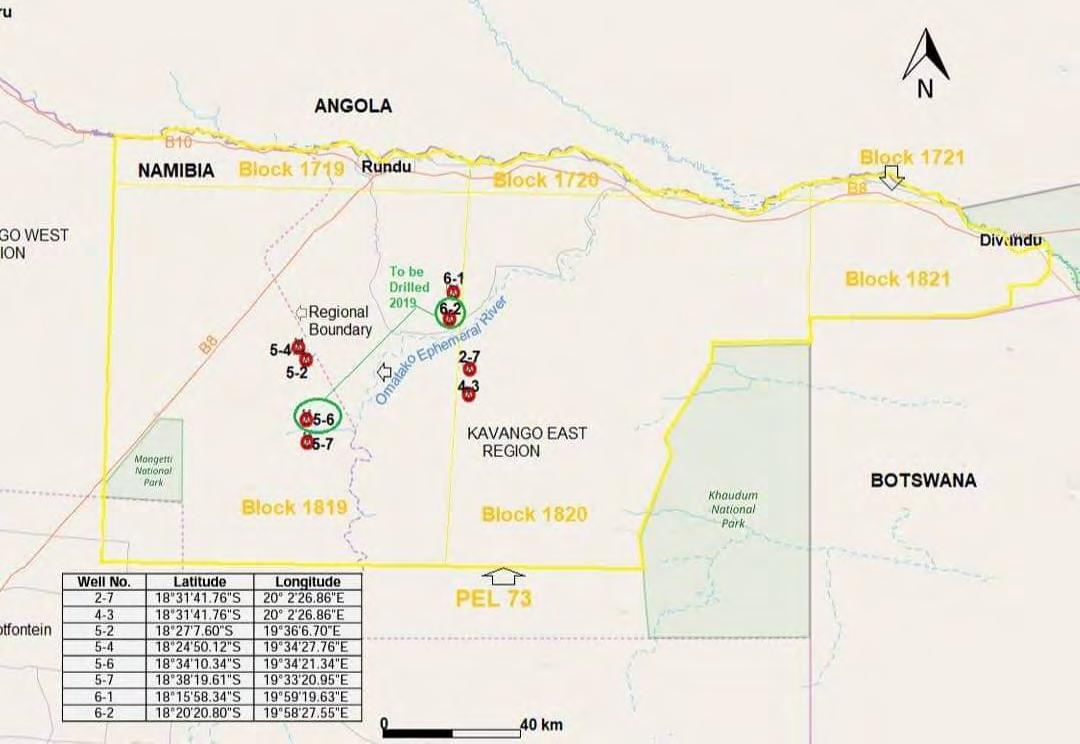
2 minute read
2.RECONNAISSANCE AFRICA – ENVIRONMENTAL IMPACT ASSESSMENT
ReconAfrica published a commissioned final Environmental Impact Assessment (EIA) report in June 2019. The three-volume assessment was submitted to apply for an Environmental Clearance Certificate with the Ministry of Environment, Forestry and Tourism in support of an existing petroleum exploration licence (No. 73) issued by the Ministry of Mines and Energy.
Advertisement
A total of eight potential drill sites are demarcated in the EIA, and two (Site 5-6 and site 6-2) are demarcated in the EIA as the two chosen drill sites. ReconAfrica’s original intention was to commence the drilling at Site 5-6 as shown on Figure 1 but it is understood that they moved to Site 6-2 due to access difficulties and drilling activities now continue at 6-1.
Annex 4 of the EIA explains that drill sites 6-1 and 6-2 fall into the Omatako basin, but slightly out of the active zone of the Omatako River. They are thus in areas of potential surface water ponding, infiltration, and groundwater through flow into the unconfined aquifer below. The two ReconAfrica drill sites are surrounded by human settlements and their water supply is tapped from porous aquifers associated with the Kalahari Sequence (Christelis and Struckmeier, 2001).
Figure 1 - Sites of ReconAfrica Exploration Wells
Annex 4 of the EIA gives a detailed description of the possible negative impacts of the surface and groundwater resources. The main report draws on Annex 4 and identifies thirteen impacts that are summarized below: 1. Aquifer pollution vulnerability.
2. Increased risk of flooding. 3. Impacts due to contaminated water discharge. 4. Impacts due to oil tank bursts and/or pipe breaks. 5. Impacts due to vehicle fuel leaks. 6. Impacts due to backwash water. 7. Impacts due to loss of drainage area.
8. Impacts due to increased or reduced runoff. 9. Impacts due to drainage pattern disturbances. 10. Impacts due to increased suspended loads. 11. Impacts due to increased risk of salinization.
12. Impacts due to disrupted groundwater flow/pathways. 13. Impacts due to elevated or reduced groundwater levels.
The EIA report concluded that most of the risks of impact were moderate to negligible so long as the proposed mitigation measures were adhered to. However, the report also acknowledged that impacts 1, 3, 4 and 6 above should be included in the associated Environmental Management Plan (EMP) due to the possible high to moderate impacts.
The report considered that long-term and cumulative impacts of the exploration activities are limited but recommended that each stratigraphic hole should be properly controlled at the top or totally plugged once the site work is completed, depending on the outcome of the exploration results. The plugging recommendation (and the sealing of aquifers) is in keeping with the industry practice (Allison and Mandler, 2018), which ReconAfrica must follow for each exploration hole.

The EIA itself recommends an assessment of surface and groundwater situation in the targeted sites:
“Project falls within the rural, communal areas where water supply is provided by the Directorate of Water Supply and Sanitation Coordination within the Department of Water Affairs (DWA) in the Ministry of Agriculture, Water and Land Reform (MWLR). In private commercial farmland, individual farm owners provide for all their water needs through the application for abstraction permits from the Department of Water Affairs. A detailed assessment of the surface
and groundwater situation within the project area is
highly recommended.” Reconnaissance Energy Namibia Final EIA report Volume 2 of 3.





